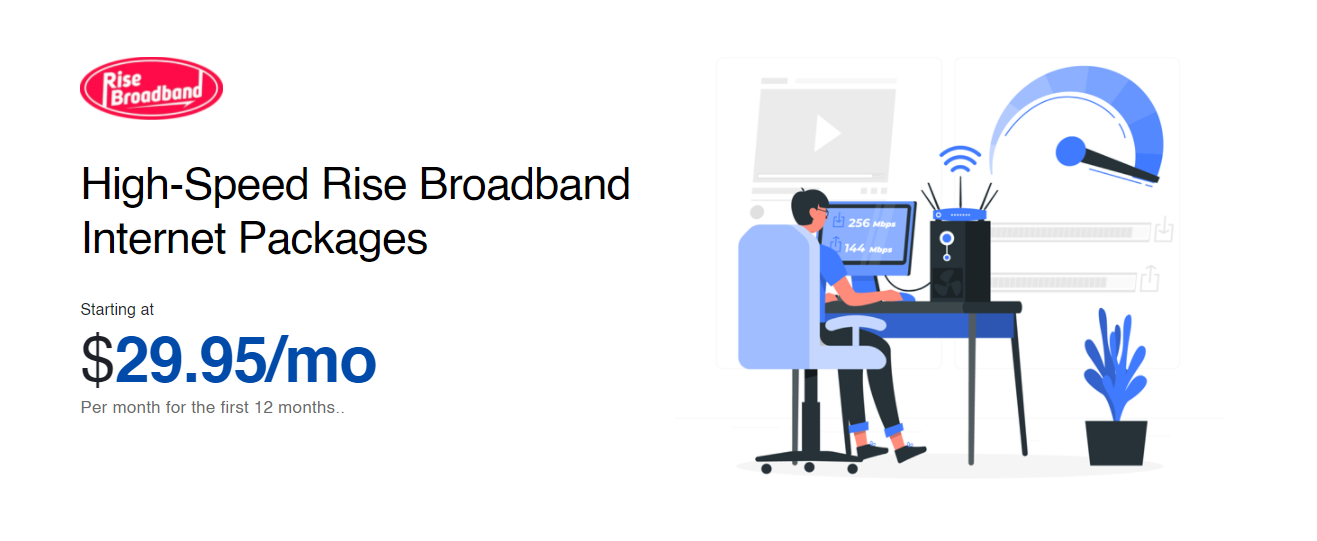From streaming videos to remote work, explore fast internet options to power your online activities efficiently.

Remember the days of dial-up, when images would load like a slow-motion reveal at an art gallery? We've certainly come a long way in internet speed.
Yet, even today, with lightning-fast connections at our fingertips, the quest for the quickest bytes continues – like modern-day gold miners panning for high-speed treasure.
In our interconnected world, speedy internet is no longer a luxury; it's a necessity for daily life. Whether we're streaming videos or working remotely, the pace of our digital existence hinges on fast connections.
This thirst for rapid data transfer is shaping the market for internet services. Consumers are constantly on the hunt for providers that can offer swifter, more reliable data pipelines to power their online activities.
Hence, it's crucial to understand the factors influencing internet speed. From geographical location to the technology that powers our connections, various elements dictate the velocity of our digital access.
In this guide, we will navigate the labyrinth of finding the fastest internet service in your vicinity. We aim to arm you with the knowledge to make an informed decision that ensures you're in the fast lane of the information superhighway.
As we proceed, remember that a swift internet connection can transform your digital experience. It's not just about speed; it's about unlocking the full potential of the web.
Understanding internet speed starts with familiarizing yourself with "Mbps," which stands for megabits per second—the universal measure of bandwidth. This figure mainly determines how swiftly data travels from the web to your devices.
In practice, higher Mbps ratings translate into faster data transmission, enhancing your online experience whether streaming in HD, engaging in competitive gaming, or managing hefty downloads. Therefore, knowing your required speed is key to tailoring your internet service effectively.
Lastly, factors like "latency"—the time it takes for data to travel to its destination—also play a critical role. Optimal latency ensures a smoother, more responsive online interaction, particularly vital in real-time applications.
Mbps stands for megabits per second, signifying the speed at which internet data is transmitted.
High Mbps can revolutionize streaming, gaming, and browsing, turning wait times into ancient history.
Latency, on the other hand, is the time data takes to travel from source to destination, and it's critical for real-time applications. A lower latency means more instantaneous reactions—essential for things like video conferencing and online gaming.
Understanding both concepts is key to optimizing your internet experience, as they affect everything from how fast web pages load to the quality of your video streams. Balancing high Mbps with low latency can lead to the pinnacle of internet performance.
Understanding your internet speed starts with accurate measurement tools—essential for diagnosing connectivity issues and verifying that you're receiving the service for which you've paid. It's a critical first step in optimizing your online experience.
Various online speed tests are available at no cost. These tests measure your connection's download and upload speeds, typically in Mbps.
Remember, when you test your speed, shut down all unnecessary applications and devices that might be using the internet. This ensures a more accurate reading of your bandwidth, free from other usage interference.
Speed measurement tools often provide additional insights, like your ping or latency. Knowing both your speed and latency can help pinpoint specific areas for potential improvement.
When choosing a speed testing tool, look for one with local test servers, as this reduces travel time for data and can provide a more accurate result for your area's actual speed capabilities.
Additionally, running multiple tests at different times helps to gauge your internet's performance consistency. Sporadic speeds could indicate issues with your service or home network setup.
When exploring high-speed Internet options, it's essential to understand the different types of connections available. Most consumers will encounter fiber-optic, digital subscriber line (DSL), cable, and satellite options in their search.
Fiber-optic connections reign supreme in speed and reliability, using light to transmit data over thin glass fibers at high bandwidths. DSL, provided through existing phone lines, offers consistency but typically lags in peak performance speed. Cable internet, meanwhile, leverages the same coaxial cable network used for cable television and can deliver rapid download speeds.
For those in rural or remote areas, satellite internet provides connectivity, although it's generally slower and more affected by weather and physical obstructions than its wired counterparts. Each connection type bears distinct advantages and limitations, reflecting the diversity in consumers’ internet needs and circumstances.
Choosing between fiber, DSL, and cable internet services hinges on balancing speed, reliability, and availability.
While DSL is widely accessible, its speed limitations may not support heavy streaming or gaming.
Fiber-optic services are the gold standard for high-speed internet, delivering gigabit speeds that are perfect for power users and smart homes.
Reliability isn't merely convenient; it's crucial.
In our hyper-connected world, a stable internet connection is the backbone of daily life and work. Consistent service is pivotal for uninterrupted video conferencing, streaming entertainment, and maintaining smart home devices. Therefore, gauging the reliability of an internet provider is as critical as assessing their speeds and technology. Disrupted connections can lead to significant inconveniences and losses.
Reliability is layered throughout the internet experience.
Providers often boast about uptime— the amount of time services are up and running. However, true reliability also hinges on consistent speeds and rapid recovery from outages. Local reputation is another valuable indicator. It speaks volumes; long-time customers can testify to the provider's dependability.
Network performance metrics matter when evaluating reliability.
It's all about service delivery when it counts - in the midst of intense gaming, critical work deadlines, or streaming your favorite series. A resilient connection is not just desirable, it's essential in today's digital landscape. Therefore, examining performance reviews and independent benchmarks is a fundamental step in assessing a provider's reliability.
The hunt for reliable internet is an ongoing mission.
Considering the vast array of user needs, from telecommuters demanding stable connections to gamers craving speed without lag, achieving an ideal balance is key. As of early 2023, this search involves critically reviewing outage reports, tracking post-outage resolutions, and understanding service level agreements. These practices ensure users pinpoint providers that can offer trustworthy connectivity in this dynamic digital age.
Diving into the local telecommunications landscape is an essential move in pinpointing the speed king of your neighborhood. Your journey should embark with a detailed inventory of all local internet service providers (ISPs), taking note of their technology base, from fiber-optic networks to advanced cable systems, and determining how their service footprints overlap with your needs. This groundwork lays the foundation for making an informed choice that aligns with your demand for robust and rapid internet access.
In this quest, wield the power of localized search tools and community forums to uncover the hidden gems of internet service. Reviews and testimonials from fellow locals often reveal the unvarnished truths about an ISP's performance and customer satisfaction. Tap into these valuable insights to steer clear of potential pitfalls and gear towards a provider who has proven their mettle in delivering top-tier internet speeds to your area.
Not all regions are created equal in speed.
When evaluating internet speeds, one can't overlook the regional disparities. Factors such as the concentration of providers, investment in infrastructure, and terrain play critical roles in determining regional internet speeds. Consequently, subscribers in urban areas may experience markedly better performance compared to those in rural regions, where options might be less abundant and technological advancements slower to arrive.
Speed discrepancies can vary widely state by state.
In some cases, a dramatic urban-rural divide exists - in cities, fiber-optic networks are often available, delivering lightning-fast speeds, while rural areas may rely on slower DSL or satellite connections. The stark contrast underscores the digital divide that persists across different geographies.
Strategies for shrinking the gap include infrastructure investments.
Given the current emphasis on connecting all Americans to high-speed internet, governmental and private sector initiatives are underway, especially since the COVID-19 pandemic highlighted the critical nature of digital access. These initiatives aim to bridge the digital chasm, providing state-of-the-art technologies like fiber and 5G to underserved communities and propelling overall regional internet capabilities into the future.
Poring over customer experiences can unveil real-world performance indicators. It often exposes the veracity of advertised internet speeds and the reliability of service that providers pledge. These grassroots insights are truly invaluable to your search.
Gone are the days of simply trusting flashy marketing; now, reviews are a treasure trove of facts that help gauge an internet provider's true colors. They illuminate the experiences of your neighbors, shedding light on how services may actually perform in your region.
While positive testimonials can be enticing, it’s the patterns in reviews that carry weight. Look for recurring themes about speed consistency, customer support, and network reliability. A single review is a data point, but clusters of feedback form a narrative worth considering.
Do not skip the negative critiques; they often reveal critical pressure points. Whether it’s about technical snafus or billing headaches, these comments are a window into potential challenges you might face with a provider. Education through feedback is your strategic advantage.
In your quest for speed, let customer reviews guide you. They can serve as a compass, pointing towards providers that deliver on their promises and avoid those leaving customers in a digital lurch.
To truly maximize your connection, it’s essential to pair your high-speed internet with an optimal network configuration. This means assessing your home setup to ensure that your router and modem are not just current but strategically positioned to diminish signal interference. Remember that the Wi-Fi signal can be weakened by obstacles like thick walls or floors, so placement is paramount. Additionally, consider augmenting your network with Wi-Fi extenders or mesh systems for comprehensive coverage, especially in larger homes. Finally, keep your devices updated to leverage the latest network capabilities, and periodically revisit your setup as technology evolves, to maintain peak internet performance.
Selecting equipment is crucial for achieving peak internet performance at home.
Investing in advanced gear can be cost-effective over time.
Upgrade periodically to keep pace with the latest internet speed capabilities.
Securing the best internet speed deal requires a strategic approach and information savvy.
Your conversation with the provider should be confident, yet courteous.
Having clear objectives and flexibility can lead to mutually beneficial speed upgrades.
Our digital journey continues unabated.
As we’ve explored, the quest for the fastest internet connection is more than a simple comparison of numbers. It's an ongoing process that involves understanding the nuanced differences in technology, recognizing the leading providers, and finding the deals that best suit our digital lives. Staying informed is pivotal as we strive to connect in the swiftest and most efficient way possible.
Keep pushing the boundaries of your internet speeds.
It's about the bigger picture – not just fast lanes of data, but how those lanes enhance your online experience. Whether it's for razor-sharp video calls, seamless streaming, or competitive gaming, matching your needs with the right speed is vital. So, keep an eye on industry trends, and don't hesitate to demand more from your service providers.
We must ride the waves of innovation and adaptation.
Changes in technology never cease, and as we move further into 2023, we should anticipate even faster and more reliable service options. This journey of connectivity and the search for speed is far from over, and staying abreast of those developments will ensure we remain at the forefront of the digital evolution.

04/06/2024
Bundling TV, internet, and phone services can provide significant benefits in terms of cost savings and convenience. By understanding what each provider offers, you can select the bundle that best fits your needs. Whether you prioritize high-speed internet, a wide range of TV channels, or reliable phone service, there's a bundle out there for you
Read More
25/11/2021
Satellite-Internet is one of the most sought-after Internet services as compared to other means of the Internet. Though speed is a concerning factor, when we talk about cable or fiber Internet connections, Satellite Internet is a preference in areas short of fiber and connections.
Read More
15/10/2021
Rise Broadband, the Nation’s leading fixed wireless service provider is a distinguished name to deliver high-speed internet and digital voice services. Headquartered in Colorado, it provides broadband services to suburban and commercial customers throughout 16 states.
Read More